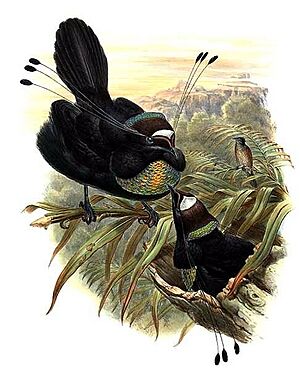Western parotia facts for kids
Quick facts for kids Western parotia |
|
|---|---|
 |
|
| Conservation status | |
| Scientific classification | |
| Genus: |
Parotia
|
| Species: |
sefilata
|
The Western Parotia (Parotia sefilata) is a cool bird-of-paradise. It's about 33 centimeters long, which is roughly the length of a ruler. This bird has a medium-length tail.
Its name, Parotia, comes from a Greek word meaning "a curl of hair by the ear." This refers to the special wires on its head. The second part of its name, sefilata, comes from Latin words meaning "six threads." This also points to those unique head wires.
Contents
What It Looks Like
Like many birds-of-paradise, male and female Western Parotias look different. This is called sexual dimorphism.
Male Western Parotia
The male is super striking! It has shiny black feathers. Its chest has bright, scale-like feathers that shimmer golden-green. On top of its head, it has silver feathers shaped like triangles.
The male also has six long, wire-like plumes (feathers) that stick out from behind its eyes. These wires have small, flat tips. They can stand up straight when the bird wants to show off!
Female Western Parotia
The female looks much simpler. She has plain brown feathers and doesn't have the fancy decorations of the male.
Where It Lives
You can only find the Western Parotia in certain places. It lives in the mountain forests of Vogelkop and the Wandammen Peninsula. Both of these areas are in Western New Guinea.
Amazing Dances and Behavior
Western Parotias have interesting ways of finding a mate. One male will mate with several females. This is called being polygynous.
Courtship Dance
Males perform amazing courtship dances on the ground. They clear a special spot in the forest for their stage.
During the dance, the male spreads his long black plumes. They look like a skirt right below his shiny chest. He also shakes his head and neck super fast! This makes his silver head feathers shimmer and sparkle. He does all this to impress the females watching him.
Nests and Diet
Only the female builds the nest and takes care of the eggs and chicks. Scientists are still learning about when they breed.
What do they eat? Mostly fruits, especially figs. They also enjoy eating small insects and other tiny creatures.
Is It Safe?
Good news! The Western Parotia is a common bird in the areas where it lives. Because of this, experts say it is a species of "Least Concern." This means it's not currently in danger of disappearing.
It is also listed in Appendix II of CITES. This means it's protected, and trading it across borders is controlled to make sure its numbers stay healthy.


